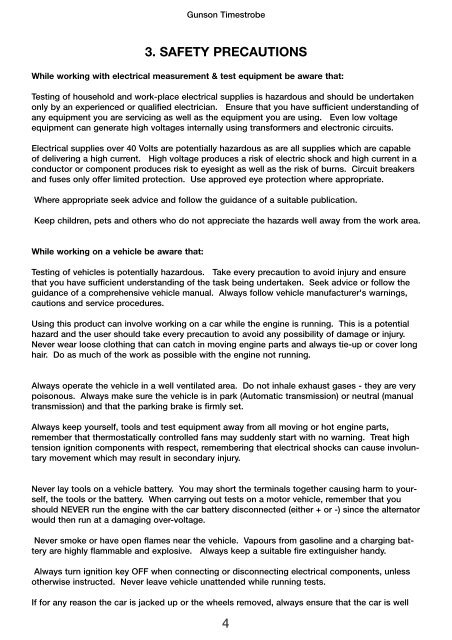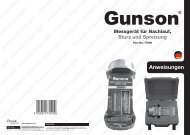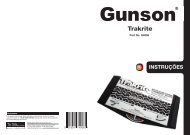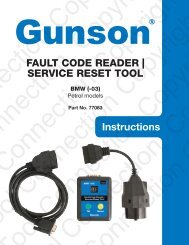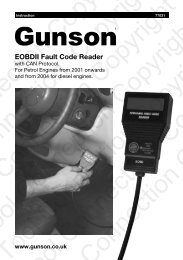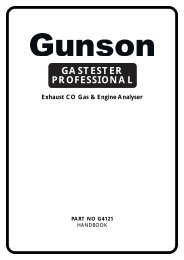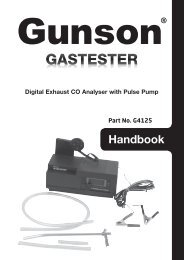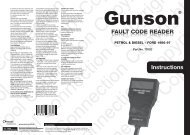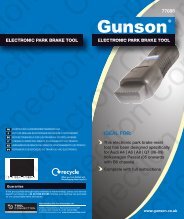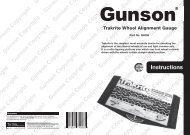POCKETMETER 2 - Gunson
POCKETMETER 2 - Gunson
POCKETMETER 2 - Gunson
Create successful ePaper yourself
Turn your PDF publications into a flip-book with our unique Google optimized e-Paper software.
<strong>Gunson</strong> Timestrobe<br />
3. SAFETY PRECAUTIONS<br />
While working with electrical measurement & test equipment be aware that:<br />
Testing of household and work-place electrical supplies is hazardous and should be undertaken<br />
only by an experienced or qualified electrician. Ensure that you have sufficient understanding of<br />
any equipment you are servicing as well as the equipment you are using. Even low voltage<br />
equipment can generate high voltages internally using transformers and electronic circuits.<br />
Electrical supplies over 40 Volts are potentially hazardous as are all supplies which are capable<br />
of delivering a high current. High voltage produces a risk of electric shock and high current in a<br />
conductor or component produces risk to eyesight as well as the risk of burns. Circuit breakers<br />
and fuses only offer limited protection. Use approved eye protection where appropriate.<br />
Where appropriate seek advice and follow the guidance of a suitable publication.<br />
Keep children, pets and others who do not appreciate the hazards well away from the work area.<br />
While working on a vehicle be aware that:<br />
Testing of vehicles is potentially hazardous. Take every precaution to avoid injury and ensure<br />
that you have sufficient understanding of the task being undertaken. Seek advice or follow the<br />
guidance of a comprehensive vehicle manual. Always follow vehicle manufacturer's warnings,<br />
cautions and service procedures.<br />
Using this product can involve working on a car while the engine is running. This is a potential<br />
hazard and the user should take every precaution to avoid any possibility of damage or injury.<br />
Never wear loose clothing that can catch in moving engine parts and always tie-up or cover long<br />
hair. Do as much of the work as possible with the engine not running.<br />
Always operate the vehicle in a well ventilated area. Do not inhale exhaust gases - they are very<br />
poisonous. Always make sure the vehicle is in park (Automatic transmission) or neutral (manual<br />
transmission) and that the parking brake is firmly set.<br />
Always keep yourself, tools and test equipment away from all moving or hot engine parts,<br />
remember that thermostatically controlled fans may suddenly start with no warning. Treat high<br />
tension ignition components with respect, remembering that electrical shocks can cause involuntary<br />
movement which may result in secondary injury.<br />
Never lay tools on a vehicle battery. You may short the terminals together causing harm to yourself,<br />
the tools or the battery. When carrying out tests on a motor vehicle, remember that you<br />
should NEVER run the engine with the car battery disconnected (either + or -) since the alternator<br />
would then run at a damaging over-voltage.<br />
Never smoke or have open flames near the vehicle. Vapours from gasoline and a charging battery<br />
are highly flammable and explosive. Always keep a suitable fire extinguisher handy.<br />
Always turn ignition key OFF when connecting or disconnecting electrical components, unless<br />
otherwise instructed. Never leave vehicle unattended while running tests.<br />
If for any reason the car is jacked up or the wheels removed, always ensure that the car is well<br />
4


